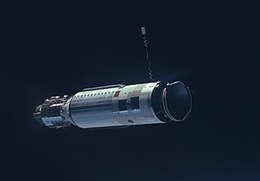Our website is made possible by displaying online advertisements to our visitors.
Please consider supporting us by disabling your ad blocker.
Agena target vehicle
 | |
| Manufacturer | |
|---|---|
| Country of origin | United States |
| Operator | NASA |
| Applications | |
| Specifications | |
| Launch mass | 18,030–18,100 pounds (8,180–8,210 kg) |
| Dry mass | 4,012–4,085 pounds (1,820–1,853 kg) |
| Dimensions |
|
| Power | Batteries |
| Equipment |
|
| Production | |
| Status | Retired |
| Built | 7 |
| Launched | 7 |
| Failed | 3 |
| Maiden launch | October 25, 1965 |
| Last launch | November 11, 1966 |
| Related spacecraft | |
| Derived from | Agena-D |
| Derivatives | Augmented Target Docking Adapter |
| Flown with | Gemini |
The Agena Target Vehicle (/əˈdʒiːnə/; ATV), also known as Gemini-Agena Target Vehicle (GATV), was an uncrewed spacecraft used by NASA during its Gemini program to develop and practice orbital space rendezvous and docking techniques, and to perform large orbital changes, in preparation for the Apollo program lunar missions.[1] The spacecraft was based on Lockheed Aircraft's Agena-D upper stage rocket, fitted with a docking target manufactured by McDonnell Aircraft. The name 'Agena' derived from the star Beta Centauri, also known as Agena. The combined spacecraft was a 26-foot (7.92 m)-long cylinder with a diameter of 5 feet (1.52 m), placed into low Earth orbit with the Atlas-Agena launch vehicle. It carried about 14,000 pounds (6,400 kg) of propellant and gas at launch,[2] and had a gross mass at orbital insertion of about 7,200 pounds (3,300 kg).
The ATV for Gemini 6 failed on launch on October 25, 1965, which led NASA to develop a backup: the Augmented Target Docking Adapter (ATDA), a smaller spacecraft consisting of the docking target with an attitude control propulsion system but without the Agena orbital change rocket. The ATDA was used once on Gemini 9A after a second ATV launch failure on May 17, 1966, but failed as a docking target because its launch shroud failed to separate.
- ^ Cite error: The named reference
ShuttleAgenaExwas invoked but never defined (see the help page). - ^ Gemini 6 Target: NASA Space Science Data Coordinated Archive
Previous Page Next Page


